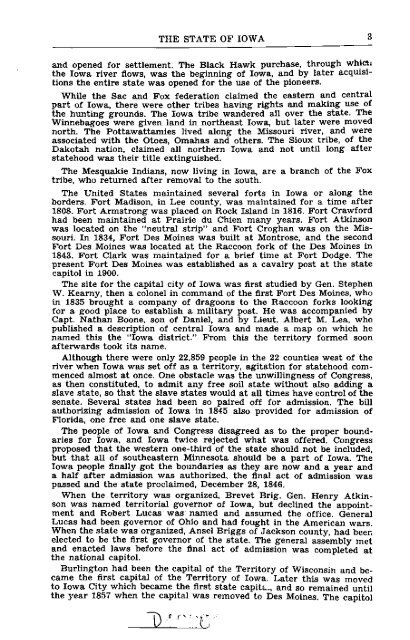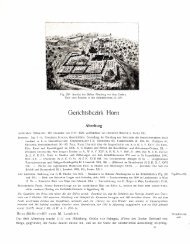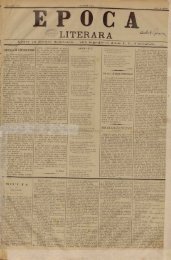- Page 1 and 2: Iowa Official Register 1945-46
- Page 3: IOWA OFFICIAL REGISTER—1945-1946
- Page 7 and 8: 6 IOWA OFFICIAL REGISTER—1945-194
- Page 9 and 10: IOWA OFFICIAL REGISTER—1945-1946
- Page 11 and 12: THE WILD ROSE, THE STATE FLOWER OF
- Page 13 and 14: Lieutenant Governor KENNETH A. EVAN
- Page 17 and 18: 1 IOWA STATE CAPITOL PARK 15 The Io
- Page 19 and 20: IOWA CONGRESSIONAL DISTRICTS 17 Iow
- Page 21 and 22: Representatives from Iowa CUNNINGHA
- Page 23 and 24: MARTIN, Thomas Ellsworth Republican
- Page 25 and 26: Auditor of State C. B. (Chet) AKERS
- Page 27 and 28: Attorney General JOHN M. RANKIN Keo
- Page 29 and 30: Superintendent of Public Instructio
- Page 31 and 32: Supreme Court Officials BLISS, Will
- Page 33 and 34: OLIVER, Ralph A., Sioux City Republ
- Page 35 and 36: Federal Court Judges in Iowa DEWEY,
- Page 37 and 38: IOWA SENATE 35 Members of the Fifty
- Page 39 and 40: IOWA SENATE 37 CLEM, A. D., Sioux C
- Page 41 and 42: IOWA SENATE FAUL, George M., Des Mo
- Page 43 and 44: IOWA SENATE 41 HENNINGSEN, O. H., C
- Page 45 and 46: IOWA SENATE 43 Jtt Mtmariwax O. J.
- Page 47 and 48: IOWA SENATE 45 J. G. LUCAS, Madrid
- Page 49 and 50: IOWA SENATE 47 NEWSOME, J. A., Denb
- Page 51 and 52: IOWA SENATE 49 SHARP, Fern Eugene,
- Page 53 and 54: IOWA SENATE 51 WHITE, Ed. S., Harla
- Page 55 and 56:
IOWA HOUSE OF REPRESENTATIVES 53 Of
- Page 57 and 58:
IOWA HOUSE OF REPRESENTATIVES 55 BA
- Page 59 and 60:
IOWA HOUSE OF REPRESENTATIVES 57 BO
- Page 61 and 62:
IOWA HOUSE OP REPRESENTATIVES 59 CO
- Page 63 and 64:
IOWA HOUSE OF REPRESENTATIVES 61 DO
- Page 65 and 66:
IOWA HOUSE OF REPRESENTATIVES 63 FL
- Page 67 and 68:
IOWA HOUSE OF REPRESENTATIVES 65 GO
- Page 69 and 70:
IOWA HOUSE OF REPRESENTATIVES 67 HU
- Page 71 and 72:
IOWA HOUSE OP REPRESENTATIVES KUEST
- Page 73 and 74:
IOWA HOUSE OF REPRESENTATIVES 71 LO
- Page 75 and 76:
IOWA HOUSE OF REPRESENTATIVES 73 Mc
- Page 77 and 78:
IOWA HOUSE OF REPRESENTATIVES 75 NE
- Page 79 and 80:
IOWA HOUSE OF REPRESENTATIVES 77 PE
- Page 81 and 82:
IOWA HOUSE OF REPRESENTATIVES 79 RE
- Page 83 and 84:
IOWA HOUSE OF REPRESENTATIVES 81 SH
- Page 85 and 86:
IOWA HOUSE OP REPRESENTATIVES STEIN
- Page 87 and 88:
IOWA HOUSE OF REPRESENTATIVES 85 TY
- Page 89 and 90:
IOWA HOUSE OP REPRESENTATIVES WALTE
- Page 91 and 92:
IOWA HOUSE OF REPRESENTATIVES 89 WI
- Page 93 and 94:
ELECTIVE EXECUTIVE DEPARTMENTS 91 L
- Page 95 and 96:
ELECTIVE EXECUTIVE DEPARTMENTS 93 a
- Page 97 and 98:
ELECTIVE EXECUTIVE DEPARTMENTS 95 D
- Page 99 and 100:
ELECTIVE EXECUTIVE DEPARTMENTS 97 D
- Page 101 and 102:
ELECTIVE EXECUTIVE DEPARTMENTS 99 T
- Page 103 and 104:
ELECTIVE EXECUTIVE DEPARTMENTS 101
- Page 105 and 106:
STATE EXECUTIVE DEPARTMENTS 103 THE
- Page 107 and 108:
STATE EXECUTIVE DEPARTMENTS 105 DEP
- Page 109 and 110:
STATE EXECUTIVE DEPARTMENTS 107 COM
- Page 111 and 112:
STATE EXECUTIVE DEPARTMENTS 109 STA
- Page 113 and 114:
STATE EXECUTIVE DEPARTMENTS HI JENS
- Page 115 and 116:
STATE EXECUTIVE DEPARTMENTS 113 HUE
- Page 117 and 118:
STATE EXECUTIVE DEPARTMENTS 115 W.
- Page 119 and 120:
STATE EXECUTIVE DEPARTMENTS 117 REI
- Page 121 and 122:
STATE EXECUTIVE DEPARTMENTS 119 190
- Page 123 and 124:
STATE EXECUTIVE DEPARTMENTS 121 sta
- Page 125 and 126:
STATE EXECUTIVE DEPARTMENTS 123 IOW
- Page 127 and 128:
STATE EXECUTIVE DEPARTMENTS 125 var
- Page 129 and 130:
STATE EXECUTIVE DEPARTMENTS 127 var
- Page 131 and 132:
STATE EXECUTIVE DEPARTMENTS 129 EME
- Page 133 and 134:
STATE EXECUTIVE DEPARTMENTS 131 mem
- Page 135 and 136:
STATE EXECUTIVE DEPARTMENTS 133 WIL
- Page 137 and 138:
STATE EXECUTIVE DEPARTMENTS 135 The
- Page 139 and 140:
STATE EXECUTIVE DEPARTMENTS 137 BOA
- Page 141 and 142:
STATE EXECUTIVE DEPARTMENTS 139 pri
- Page 143 and 144:
STATE EXECUTIVE DEPARTMENTS 141 Sta
- Page 145 and 146:
STATE EXECUTIVE DEPARTMENTS 143 For
- Page 147 and 148:
STATE EXECUTIVE DEPARTMENTS 145 FIS
- Page 149 and 150:
STATE EXECUTIVE DEPARTMENTS 147 imp
- Page 151 and 152:
STATE EXECUTIVE DEPARTMENTS 149 The
- Page 153 and 154:
STATE EXECUTIVE DEPARTMENTS 151 STA
- Page 155 and 156:
STATE EXECUTIVE DEPARTMENTS 153 min
- Page 157 and 158:
STATE EXECUTIVE DEPARTMENTS 155 INT
- Page 159 and 160:
STATE EXECUTIVE DEPARTMENTS 157 "Me
- Page 161 and 162:
REPORT OF EXECUTIVE COUNCIL 159 Rep
- Page 163 and 164:
REPORT OF EXECUTIVE COUNCIL 161 Com
- Page 165 and 166:
REPORT OF EXECUTIVE COUNCIL 163 Com
- Page 167 and 168:
REPORT OF EXECUTIVE COUNCIL 165 lan
- Page 169 and 170:
REPORT OF EXECUTIVE COUNCIL 167 Com
- Page 171 and 172:
GOVERNMENT OF IOWA 169 assembly has
- Page 173 and 174:
CALENDAR OF OFFICIAL DATES 171 ment
- Page 175 and 176:
CALENDAR OF OFFICIAL DATES 173 wher
- Page 177 and 178:
COURTS OF IOWA 175 Courts of Iowa S
- Page 179 and 180:
COURTS OF IOWA 177 FIFTEENTH JUDICI
- Page 181 and 182:
IOWA POPULATION STATISTICS 179 STAT
- Page 183 and 184:
COUNTY OFFICERS 181 COUNTY OFFICERS
- Page 185 and 186:
COUNTY OFFICERS 183 11 BUENA VISTA
- Page 187 and 188:
COUNTY OFFICERS 185 21 CLAY COUNTY
- Page 189 and 190:
COUNTY OFFICERS 187 31 DUBUQUE COUN
- Page 191 and 192:
COUNTY OFFICERS 189 41 HANCOCK COUN
- Page 193 and 194:
COUNTY OFFICERS 191 51 JEFFERSON CO
- Page 195 and 196:
COUNTY OFFICERS 193 61 MADISON COUN
- Page 197 and 198:
COUNTY OFFICERS 195 71 O'BRIEN COUN
- Page 199 and 200:
COUNTY OFFICERS 197 81 SAC COUNTY
- Page 201 and 202:
COUNTY OFFICERS 199 91 WARREN COUNT
- Page 203 and 204:
IOWA PUBLICATIONS 201 LIST OF IOWA
- Page 205 and 206:
NEWSPAPERS OF IOWA 203 Newspapers i
- Page 207 and 208:
NEWSPAPERS OF IOWA 205 Newspapers i
- Page 209 and 210:
NEWSPAPERS OF IOWA 207 Newspapers i
- Page 211 and 212:
NEWSPAPERS OF IOWA 209 Newspapers i
- Page 213 and 214:
NEWSPAPERS OF IOWA 211 Newspapers i
- Page 215 and 216:
NEWSPAPERS OF IOWA 213 Newspapers i
- Page 217 and 218:
STATE PARKS AND PRESERVES 215 Name
- Page 219 and 220:
IOWA POPULATION STATISTICS 217 Popu
- Page 221 and 222:
IOWA POPULATION STATISTICS 219 Popu
- Page 223 and 224:
IOWA POPULATION STATISTICS 221 Popu
- Page 225 and 226:
EDUCATIONAL INSTITUTIONS 223 ating
- Page 227 and 228:
EDUCATIONAL INSTITUTIONS 225 a natu
- Page 229 and 230:
EDUCATIONAL INSTITUTIONS 227 Iowa S
- Page 231 and 232:
EDUCATIONAL INSTITUTIONS 229 quarte
- Page 233 and 234:
EDUCATIONAL INSTITUTIONS 231 JOHN F
- Page 235 and 236:
IOWA INSTITUTIONS 233 Life is lived
- Page 237 and 238:
IOWA HIGHWAY SAFETY PATROL 235 Iowa
- Page 239 and 240:
MOTOR VEHICLES 237 Motor Vehicles T
- Page 241 and 242:
IOWA IN WORLD WAR I 239 The statist
- Page 243 and 244:
GRAND ARMY OF THE REPUBLIC 241 Gran
- Page 245 and 246:
ROAD SYSTEM 243 The department rece
- Page 247 and 248:
MEMBERS OF THE GENERAL ASSEMBLY 245
- Page 249 and 250:
PRESIDENTS OF THE SENATE 247 LEGISL
- Page 251 and 252:
STATE OFFICIALS 249 LIEUTENANT GOVE
- Page 253 and 254:
STATE OFFICIALS 251 TREASURERS OF S
- Page 255 and 256:
Chas. Mason Joseph Williams. Name S
- Page 257 and 258:
UNITED STATES OFFICIALS FROM IOWA 2
- Page 259 and 260:
UNITED STATES OFFICIALS FOR IOWA 25
- Page 261 and 262:
IOWANS IN PRESIDENTS' CABINETS 259
- Page 263 and 264:
THE INDIANS IN IOWA 261 The Indians
- Page 265 and 266:
PRIMARY ELECTION, JUNE 5, 1944 263
- Page 267 and 268:
PRIMARY ELECTION, JUNE 5, 1944 265
- Page 269 and 270:
PRIMARY ELECTION, JUNE 5, 1944 267
- Page 271 and 272:
PRIMARY ELECTION, JUNE 5, 1944 269
- Page 273 and 274:
PRIMARY ELECTION, JUNE 5, 1944 271
- Page 275 and 276:
PRIMARY ELECTION, JUNE 5, 1944 273
- Page 277 and 278:
PRIMARY ELECTION, JUNE 5, 1944 275
- Page 279 and 280:
GENERAL ELECTION, NOVEMBER 7, 1944
- Page 281 and 282:
GENERAL ELECTION, NOVEMBER 7, 1944
- Page 283 and 284:
GENERAL ELECTION, NOVEMBER 7, 1944
- Page 285 and 286:
GENERAL ELECTION, NOVEMBER 7, 1944
- Page 287 and 288:
GENERAL ELECTION, NOVEMBER 7, 1944
- Page 289 and 290:
GENERAL ELECTION, NOVEMBER 7, 1944
- Page 291 and 292:
GENERAL ELECTION, HOLD-OVER SENATOR
- Page 293 and 294:
GENERAL ELECTION, STATE REPRESENTAT
- Page 295 and 296:
General Election Returns By Precinc
- Page 297 and 298:
GENERAL ELECTION, NOVEMBER 7, 1944
- Page 299 and 300:
GENERAL ELECTION, NOVEMBER 7, 1944
- Page 301 and 302:
GENERAL ELECTION, NOVEMBER 7, 1944
- Page 303 and 304:
GENERAL ELECTION, NOVEMBER 7, 1944
- Page 305 and 306:
GENERAL ELECTION, NOVEMBER 7, 1944
- Page 307 and 308:
GENERAL ELECTION, NOVEMBER 7, 1944
- Page 309 and 310:
GENERAL ELECTION, NOVEMBER 7, 1944
- Page 311 and 312:
GENERAL ELECTION, NOVEMBER 7, 1944
- Page 313 and 314:
GENERAL ELECTION, NOVEMBER 7, 1944
- Page 315 and 316:
GENERAL ELECTION, NOVEMBER 7, 1944
- Page 317 and 318:
GENERAL ELECTION, NOVEMBER 7, 1944
- Page 319 and 320:
GENERAL ELECTION, NOVEMBER 7, 1944
- Page 321 and 322:
GENERAL ELECTION, NOVEMBER 7, 1944
- Page 323 and 324:
GENERAL ELECTION, NOVEMBER 7, 1944
- Page 325 and 326:
GENERAL ELECTION, NOVEMBER 7, 1944
- Page 327 and 328:
GENERAL ELECTION, NOVEMBER 7, 1944
- Page 329 and 330:
GENERAL ELECTION, NOVEMBER 7, 1944
- Page 331 and 332:
GENERAL ELECTION, NOVEMBER 7, 1944
- Page 333 and 334:
GENERAL ELECTION, NOVEMBER 7, 1944
- Page 335 and 336:
GENERAL ELECTION, NOVEMBER 7, 1944
- Page 337 and 338:
GENERAL ELECTION, NOVEMBER 7, 1944
- Page 339 and 340:
GENERAL ELECTION, NOVEMBER 7, 1944
- Page 341 and 342:
GENERAL ELECTION, NOVEMBER 7, 1944
- Page 343 and 344:
GENERAL ELECTION, NOVEMBER 7, 1944
- Page 345 and 346:
GENERAL ELECTION, NOVEMBER 7, 1944
- Page 347 and 348:
GENERAL ELECTION, NOVEMBER 7, 1944
- Page 349 and 350:
GENERAL ELECTION, NOVEMBER 7, 1944
- Page 351 and 352:
GENERAL ELECTION, NOVEMBER 7, 1944
- Page 353 and 354:
GENERAL ELECTION, NOVEMBER 7, 1944
- Page 355 and 356:
GENERAL ELECTION, NOVEMBER 7, 1944
- Page 357 and 358:
GENERAL ELECTION, NOVEMBER 7, 1944
- Page 359 and 360:
GENERAL ELECTION, NOVEMBER 7, 1944
- Page 361 and 362:
GENERAL ELECTION, NOVEMBER 7, 1944
- Page 363 and 364:
GENERAL ELECTION, NOVEMBER 7, 1944
- Page 365 and 366:
GENERAL ELECTION, NOVEMBER 7, 1944
- Page 367 and 368:
GENERAL ELECTION, NOVEMBER 7, 1944
- Page 369 and 370:
GENERAL ELECTION, NOVEMBER 7, 1944
- Page 371 and 372:
GENERAL ELECTION, NOVEMBER 7, 1944
- Page 373 and 374:
GENERAL ELECTION, NOVEMBER 7, 1944
- Page 375 and 376:
GENERAL ELECTION, NOVEMBER 7, 1944
- Page 377 and 378:
GENERAL ELECTION, NOVEMBER 7, 1944
- Page 379 and 380:
GENERAL ELECTION, NOVEMBER 7, 1944
- Page 381 and 382:
GENERAL ELECTION, NOVEMBER 7, 1944
- Page 383 and 384:
GENERAL ELECTION, NOVEMBER 7, 1944
- Page 385 and 386:
GENERAL ELECTION, NOVEMBER 7, 1944
- Page 387 and 388:
THE CONSTITUTION OF IOWA 385 SEC. 4
- Page 389 and 390:
THE CONSTITUTION OF IOWA 387 LEGISL
- Page 391 and 392:
THE CONSTITUTION OF IOWA 389 throug
- Page 393 and 394:
THE CONSTITUTION OF IOWA 391 SEC. 1
- Page 395 and 396:
THE CONSTITUTION OF IOWA 393 of the
- Page 397 and 398:
THE CONSTITUTION OF IOWA 395 or oth
- Page 399 and 400:
THE CONSTITUTION OF IOWA 397 SEC. 7
- Page 401 and 402:
THE CONSTITUTION OF IOWA 399 AMENDM
- Page 403 and 404:
THE DECLARATION OF INDEPENDENCE 401
- Page 405 and 406:
THE CONSTITUTION OF THE UNITED STAT
- Page 407 and 408:
THE CONSTITUTION OF THE UNITED STAT
- Page 409 and 410:
THE CONSTITUTION OF THE UNITED STAT
- Page 411 and 412:
THE CONSTITUTION OF THE UNITED STAT
- Page 413 and 414:
THE CONSTITUTION OF THE UNITED STAT
- Page 415 and 416:
THE CONSTITUTION OF THE UNITED STAT
- Page 417 and 418:
INDEX 415 Page Congressmen from Iow
- Page 419 and 420:
INDEX 417 Page Keokuk County Office
- Page 421:
INDEX 419 Page State Bird 10 State
















